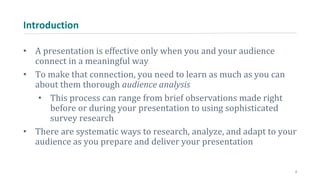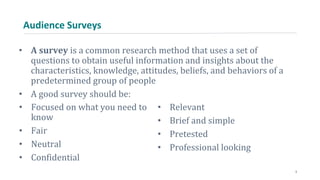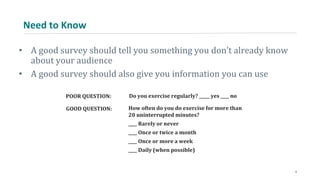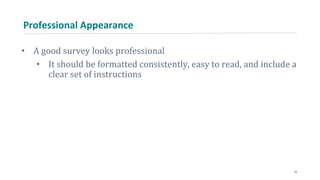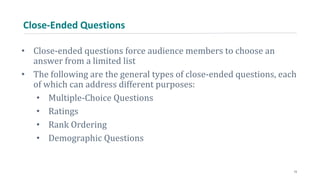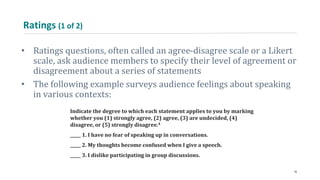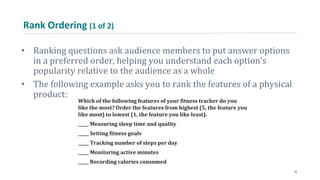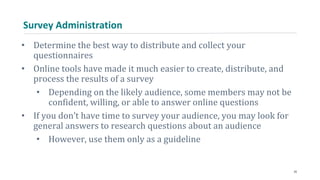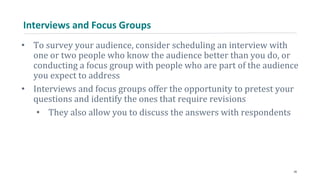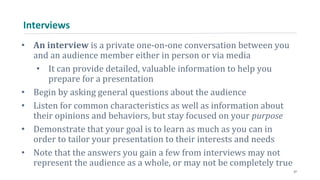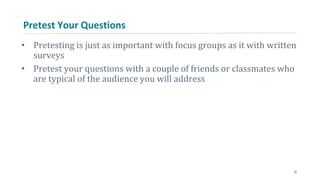Norton Field Guide for Speaking 9.1
- 1. Chapter 9.1 How to Survey an Audience Copyright © 2022 W. W. Norton & Company
- 2. Introduction • A presentation is effective only when you and your audience connect in a meaningful way • To make that connection, you need to learn as much as you can about them thorough audience analysis • This process can range from brief observations made right before or during your presentation to using sophisticated survey research • There are systematic ways to research, analyze, and adapt to your audience as you prepare and deliver your presentation 2
- 3. Audience Surveys • A survey is a common research method that uses a set of questions to obtain useful information and insights about the characteristics, knowledge, attitudes, beliefs, and behaviors of a predetermined group of people • A good survey should be: • Focused on what you need to know • Fair • Neutral • Confidential • Relevant • Brief and simple • Pretested • Professional looking 3
- 4. Need to Know • A good survey should tell you something you don’t already know about your audience • A good survey should also give you information you can use POOR QUESTION: Do you exercise regularly? _____ yes ____ no GOOD QUESTION: How often do you do exercise for more than 20 uninterrupted minutes? ____ Rarely or never ____ Once or twice a month ____ Once or more a week ____ Daily (when possible) 4
- 5. Fairness • A good survey should be fair • Don’t ask questions that “force survey respondents to choose an answer that doesn’t reflect their opinion, thereby making your data unreliable” 5
- 6. Neutrality • Avoid asking questions that all but force people to respond in ways that favor the survey taker’s position • Ethical survey researchers avoid questions that evoke only the opinions they want responders to agree with 6
- 7. Confidentiality • A good survey is confidential • Respondents are more likely to give you honest information about themselves, their opinions, and their behavior if you don’t ask for their names or other identifying information 7
- 8. Relevance, Brevity and Simplicity • Only ask questions that are relevant to your topic and purpose • Avoid asking too many questions • Use simple, concrete, and grammatically correct language, and steer clear of clichés, abbreviations, and jargon 8
- 9. Pretesting • Pretest questions to check if respondents are interpreting their meaning as intended • If you discover your questions are vague or don’t gather the kind of information you need, make changes to your questionnaire and pretest the revision as well 9
- 10. Professional Appearance • A good survey looks professional • It should be formatted consistently, easy to read, and include a clear set of instructions 10
- 11. Types of Survey Questions • There are two broad types of survey questions: • Open ended • Close ended • Consider your purpose as well as the kind of information you think will be most useful when preparing your presentation • Whenever possible, use more than one type of question 11
- 12. Open-Ended Questions • Open-ended questions allow audience members to provide detailed answers • The answers to open-ended question are very valuable, but be careful not to overuse them • One or two good open-ended questions is enough, but don’t put them back-to-back 12
- 13. Close-Ended Questions • Close-ended questions force audience members to choose an answer from a limited list • The following are the general types of close-ended questions, each of which can address different purposes: • Multiple-Choice Questions • Ratings • Rank Ordering • Demographic Questions 13
- 14. Multiple-Choice Questions (1 of 2) • Multiple-choice questions are popular because they provide the clearest results • The following is an example of a multiple-choice question that asks for a single answer: In your opinion, what percentage of your daily communicating time do you spend listening? _____ More than 70 percent _____ 40–70 percent _____ 20–39 percent _____ 10–19 percent _____ Less than 10 percent 14
- 15. Multiple-Choice Questions (2 of 2) The following is an example of a checklist that allows a fixed or unfixed number of multiple answers: Which beliefs and values are most important to you? You may check one or more answers. _____ Individuality and self-interest take precedence over group interests. _____ All forms of authority, including government, should be viewed with suspicion. _____ Your personal success depends on acceptance among your peers. _____ You should belong to an organized religious institution. _____ All human beings are equal. _____ America is a symbol of progress. _____ Protecting our environment is a moral and survival issue. 15
- 16. Ratings (1 of 2) • Ratings questions, often called an agree-disagree scale or a Likert scale, ask audience members to specify their level of agreement or disagreement about a series of statements • The following example surveys audience feelings about speaking in various contexts: Indicate the degree to which each statement applies to you by marking whether you (1) strongly agree, (2) agree, (3) are undecided, (4) disagree, or (5) strongly disagree.4 _____ 1. I have no fear of speaking up in conversations. _____ 2. My thoughts become confused when I give a speech. _____ 3. I dislike participating in group discussions. 16
- 17. Ratings (2 of 2) The following example asks respondents to think about the importance of specific speaking skills: How would you rate the following items in terms of their importance to you in becoming a more effective speaker? Circle one of the numbers for each of the four items that represent how important or unimportant it is as a presentation speaking skill. Blank Extremely important Very important Somewhat important Not very important Not at all important 1. Organizing a presentation 5 4 3 2 1 2. Adapting to an audience 5 4 3 2 1 3. Speaking impromptu 5 4 3 2 1 4. Persuading an audience 5 4 3 2 1 17
- 18. Rank Ordering (1 of 2) • Ranking questions ask audience members to put answer options in a preferred order, helping you understand each option’s popularity relative to the audience as a whole • The following example asks you to rank the features of a physical product: Which of the following features of your fitness tracker do you like the most? Order the features from highest (5, the feature you like most) to lowest (1, the feature you like least). _____ Measuring sleep time and quality _____ Setting fitness goals _____ Tracking number of steps per day _____ Monitoring active minutes _____ Recording calories consumed 18
- 19. Rank Ordering (2 of 2) The second example asks you to rank the quality of customer service in five fast-food chains: Which of the following fast-food chains provide the best customer service? Order them from best (5, the best customer service) to worst (1, the customer service you like the least). Do not rate the food. _____ McDonald’s _____ Burger King _____ Chipotle _____ Chick-fi l-A _____ Wendy’s 19
- 20. Demographic Questions (1 of 2) • Demographic survey questions collect information about audience demographics such as age, gender, race, marital status, religion, income, and occupation • These answers can help you segment your audience based on who they are and what they do 20
- 21. Demographic Questions (2 of 2) Consider the following examples: How would you describe your political viewpoint? ____ Very liberal ____ Slightly liberal ____ Slightly conservative ____ Very conservative ____ Prefer not to say To which generation do you belong? ____ Greatest Generation (born 1901–27) ____ Silent Generation (1928–45) ____ Baby Boomers (1946–64) ____ Generation X (1965–80) ____ Millennials or Generation Y (1981–96) ____ Generation Z or Zoomers (1997–2012) 21
- 22. How to Use Demographic Data (1 of 3) • Some people may be reluctant to answer questions about their age, gender, ethnicity, religion, income, occupation, marital status, and more because they don’t want to box themselves into a category • They also may want to keep that sort of information private • However, the answers to such questions can sometimes be very valuable • They help you identify factors that may influence how people will respond to your presentation • They let you compare and contrast the responses of various subgroups 22
- 23. How to Use Demographic Data (2 of 3) • When asking about demographic information, make sure the answer options adapt to probable characteristics of your audience • Alternatively, you could use an open-ended question, but the results would be more difficult to tabulate and summarize • Try to be inclusive and avoid upsetting members who are left off a demographic checklist when asking audience members questions • The way you ask and use the answers to demographic questions can vary depending on the rhetorical situation and whether you really need to know the answers • Always ask yourself if you really need to know the answer to this question in order to understand and adapt to your audience 23
- 24. How to Use Demographic Data (3 of 3) Consider the following example where changes in race and ethnicity designations are adapted to by combining the categories into a single question that alphabetizes all but the last three options: Which of the following categories best describes you? ____ Asian or Pacific Islander ____ Black or African American ____ Hispanic or Latino ____ Native American or Alaskan Native ____ White or Caucasian ____ Multiracial or biracial ____ My race/ethnicity is not listed here. ____ I prefer to not answer this question. 24
- 25. Survey Administration • Determine the best way to distribute and collect your questionnaires • Online tools have made it much easier to create, distribute, and process the results of a survey • Depending on the likely audience, some members may not be confident, willing, or able to answer online questions • If you don’t have time to survey your audience, you may look for general answers to research questions about an audience • However, use them only as a guideline 25
- 26. Interviews and Focus Groups • To survey your audience, consider scheduling an interview with one or two people who know the audience better than you do, or conducting a focus group with people who are part of the audience you expect to address • Interviews and focus groups offer the opportunity to pretest your questions and identify the ones that require revisions • They also allow you to discuss the answers with respondents 26
- 27. Interviews • An interview is a private one-on-one conversation between you and an audience member either in person or via media • It can provide detailed, valuable information to help you prepare for a presentation • Begin by asking general questions about the audience • Listen for common characteristics as well as information about their opinions and behaviors, but stay focused on your purpose • Demonstrate that your goal is to learn as much as you can in order to tailor your presentation to their interests and needs • Note that the answers you gain a few from interviews may not represent the audience as a whole, or may not be completely true 27
- 28. Focus Groups (1 of 2) • A focus group is an exploratory, qualitative research method where people discuss a series of carefully selected questions guided by a moderator • Focus groups may take some effort, but they can be just as valuable as a good survey if planned and conducted with care • The following are some basic guidelines for conducting a productive focus group: • Develop Appropriate Survey Questions: Ask a few broad questions (fewer than in a written survey) ranked in order of importance, have group members to explain their answer, and observe how they respond to group members who chose other answers 28
- 29. Focus Groups (2 of 2) • The following are some basic guidelines for conducting a productive focus group: • Develop appropriate survey questions • Select your participants carefully • Pretest your questions • Bring an agenda • Facilitate conversation 29
- 30. Develop Appropriate Survey Questions • Ask fewer, broader questions than in a written survey that allow participants to provide longer answers • Rank them in order of importance • Ask group members to explain why they chose a particular answer • Observe how they respond to other group members who chose different answers • Ask more specific follow-up questions 30
- 31. Select Your Participants Carefully • Choose people who represent the demographics, attitudes, and behaviors of your target audience • Research potential participants and invite people who agree, disagree, and are undecided 31
- 32. Pretest Your Questions • Pretesting is just as important with focus groups as it with written surveys • Pretest your questions with a couple of friends or classmates who are typical of the audience you will address 32
- 33. Bring an Agenda • Having an agenda will help you stay on track and use your time wisely • Start by asking participants their names and for an explanation of why they might attend a presentation like the one you’re preparing • Ask questions that probe deeper than a written survey could to understand how people think and feel about the topic • Use effective listening skills and clear and oral speaking styles, and pay attention to nonverbal behavior 33
- 34. Facilitate Conversation • Make sure you include everyone in the discussion • Pay special attention to those who speak less, seem unwilling to participate, or are hesitant to disagree with other members • A focus group gives you a sense of how the full audience might react, but keep in mind that it may not be a highly representative sample of the audience population 34
- 35. Midpresentation Surveys and Adaptations • Surveys involve looking at and listening carefully to people in order to gain information about them, regardless of the setting or mode • Surveying, analyzing, and adapting to an audience can and should continue as you speak • Engage in a midpresentation survey that analyzes audience reactions and justifies modifications to your message, especially if your audience or their reactions are not what you expected • Responding to the audience’s behavior and then modifying your presentation accordingly differentiates just making a speech and achieving your purpose 35
- 36. Credits This concludes the Lecture PowerPoint presentation for Chapter 9.1. For more resources, please visit The Norton Field Guide to Speaking: http://digital.wwnorton.com/nfgspeaking. Copyright © 2022 W. W. Norton & Company
Editor's Notes
- #6: What Is a Survey?” Qualtrics, accessed April 11, 2021, https://www.qualtrics.com/experience -management/research/survey-basics
- #22: Clint Fontanella, “The 14 Best Demographic Questions to Use in Surveys,” HubSpot, updated March 17, 2021, https://blog.hubspot.com/service /survey-demographic-questions
- #28: 5.3: Conducting Audience Analysis,” Stand Up, Speak Out: The Practice and Ethics of Public Speaking (Minneapolis: University of Minnesota Libraries Publishing, 2016), https://open.lib.umn.edu /publicspeaking/chapter/5-3-conducting-audience -analysis
- #31: “Questionnaire Design,” Pew Research Center, accessed April 11, 2021, https://www.pewresearch .org/methods/u-s-survey-research/questionnaire -design


